Author: Ray Marchica
Roadster Salon Spider Tributo’s Has Arrived
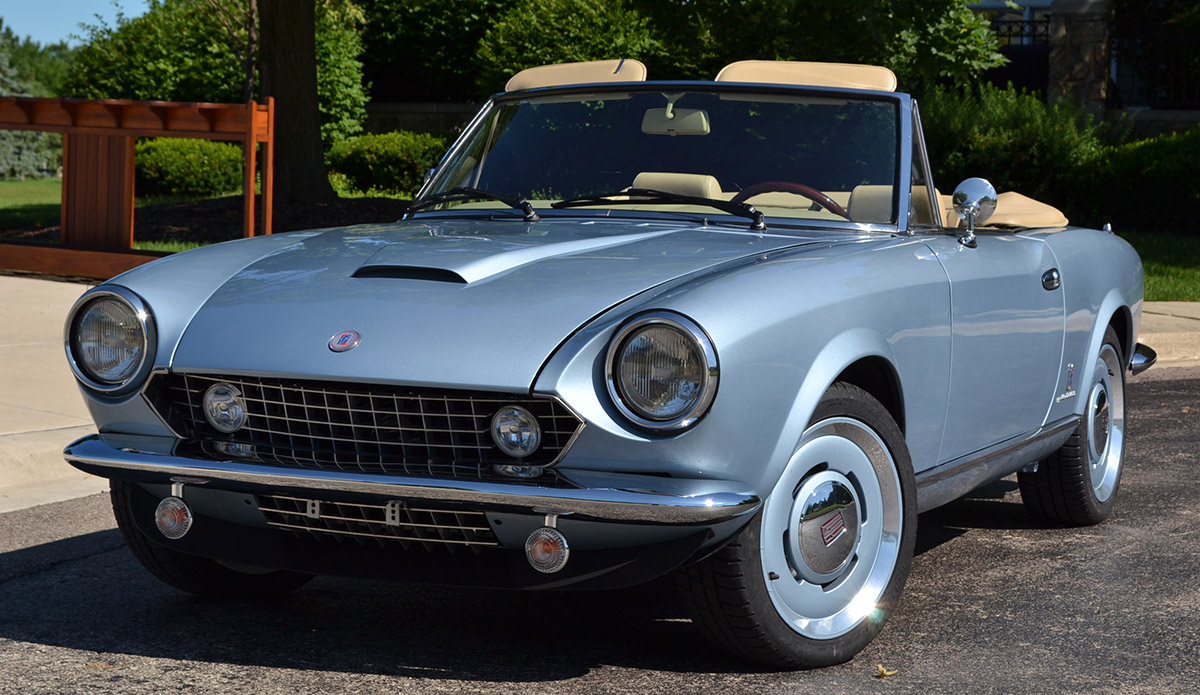
My Dad loved metaphors, slogans and “isms”. One of his favorites was “In life, things never stay the same. You are either getting better or getting worse.” This slogan became his business mantra, as he constantly urged us to improve. Dad wanted every car we build to be better than the one that came before it. To him, anything less meant staying the same—and that was synonymous with failure.
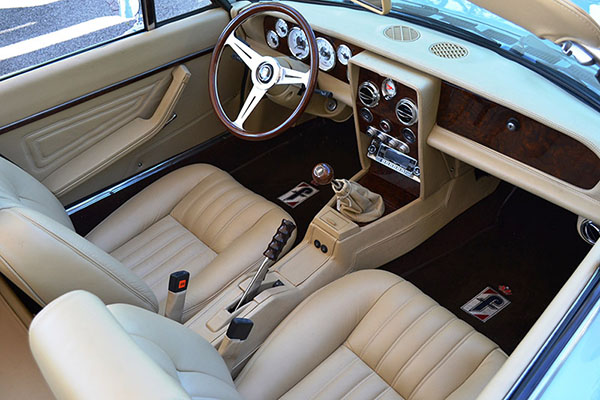

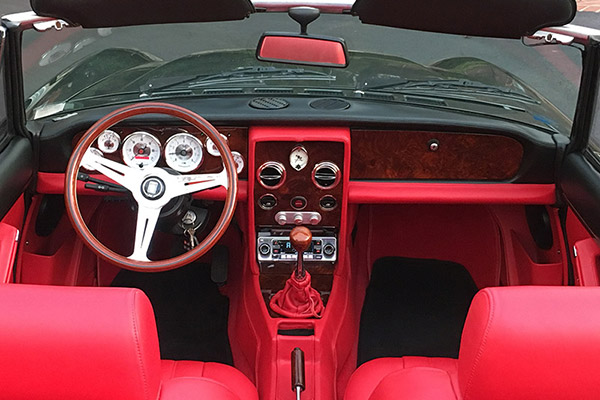
The new Tributo is based on the immensely popular Lusso S2
Roadster Salon is always moving forward, refining our vision. While the original Lusso was mostly a cosmetic exercise, the Series Two was a sincere effort to update the Spider and make it more in tune with today’s drivers and roads. Several years after my Dad passed away, I remember sitting down with our engineers in the conference room, and listing a stock spider’s shortcomings on a legal pad. “The car doesn’t stop. Its electrical system needs to be updated or it will never be reliable. It rattles like crazy. A Spider can’t keep up with traffic. And it steers like an old truck”. The criticism was harsh, but fair.
My Dad always resisted modifying the Spider, because he wanted our restorations to maintain their originality. He worried the car would lose its charm if the changes were poorly conceived or badly executed. His worries aside, I knew our Spiders need more than just better fit and finish. They had to drive better too. Trying to make upgrades using commonly available parts was not an option. It had been tried too many times unsuccessfully. We needed new ideas, designed and fabricated by our own staff. Once we got the engineers on board, the solutions came with comparative ease.
Proudly, the Lusso S2 has become our most valued effort. It is a rolling showcase for Roadster Salon’s exclusive technology, and made the Spider a safer, more contemporary driving experience. We’ve spent countless hours and thousands of miles behind the wheel of our Lusso development vehicles, detailing how they behaves under a variety of road conditions. When compared to a stock Spider, the current Lusso S2 is a dream concept. It is far beyond the fit, finish and performance capabilities of an original Fiat Spider. Yet, further improvements were still possible. The Tributo is our next step.
What is a Tributo, and how does it differ from a Lusso S2?
The idea for the Tributo came to us about a year ago, when a creative customer suggested doing a themed version of the Lusso S2. A true Italian car enthusiast, he correctly noted the DNA running through the veins of all Spiders originated from vintage Ferraris and Maseratis. Our customer wanted to “pay tribute” to those classic roadsters from the 60’s and 70’s. He wondered aloud if some of those design elements could be merged with the basic Lusso platform. We loved the premise. I saw it as an opportunity to take the Lusso to an even higher level of custom design and performance.
Once again, the yellow pad came out. But this time, not only to outline areas where performance could be improved. We took the lid off and re-imagined the entire car. We quickly realized that it’s much more difficult to improve something that’s already very good, versus something with obvious flaws. Roadster Salon’s team was up for the challenge and focused on refinement, detail and aesthetics.
To suit the taste of both luxury and performance-oriented customers, we decided to build two different versions of the Tributo. A Maserati themed version and one inspired by Ferrari. Each have their own unique personalities.
For the Maserati Tributo, our first area of attention was the interior. Our design team’s focus was to upgrade it cosmetically while also making it more functional and luxurious. The directive was to keep these improvements within the context of a Maserati inspired theme. The new Tributo incorporates an entirely new dash design. It features custom white-faced LED gauges with a GPS tracked odometer and speedo, plus a real Maserati jewel-like clock as a binnacle centerpiece. The entire package is trimmed with hand stitched Maserati sourced leather.
Next on the agenda was performance. Early in the process, we decided to include exclusive technology planned for a future Lusso S3 into the Tributo. The decision was aimed to bring newly developed engineering improvements to the market immediately, rather than waiting for a revision scheduled for next year. Consequently, the Tributo features our Generation II rack and pinion steering system, second generation structural chassis bracing, and a Maserati inspired multi-piston braking system. The Tributo’s suspension and drive line has also received some subtle tweaks beyond the current Lusso S2. An improved automatic transmission and power steering are available options.
The cherry on top is a choice between real Boranni wire wheels or custom scaled and adapted Maserati alloys. Each car is finished exclusively in a color from Maserati’s factory color chart with more extensive paint preparation and better finishing than a standard Lusso S2. For a limited time, the Tributo Maserati package will be priced at $15,995 (plus the cost of a base Lusso S2).
Roadster Salon Spider Tributo Ferrari
Our Ferrari inspired Tributo is similar in concept to the Maserati version. However, this second themed model has more emphasis on sport. It is designed for those seeking a slightly harder edged car, with even sharper reflexes. As expected, interior and exterior colors are from the factory Ferrari color palate. The Tributo Ferrari will also have a non-functional version of the custom hood found only on the Spider America. Gauge faces can be black or yellow in addition to white. A Ferrari inspired dash arrangement differing in detail from the Maserati version will be included. Stiffer suspension settings and a shorter throw five speed transmission is also standard.
Orders for both models are being taken now for Spring 2019 delivery on a first come basis. Learn More.
Roadster Salon Expands Service Department
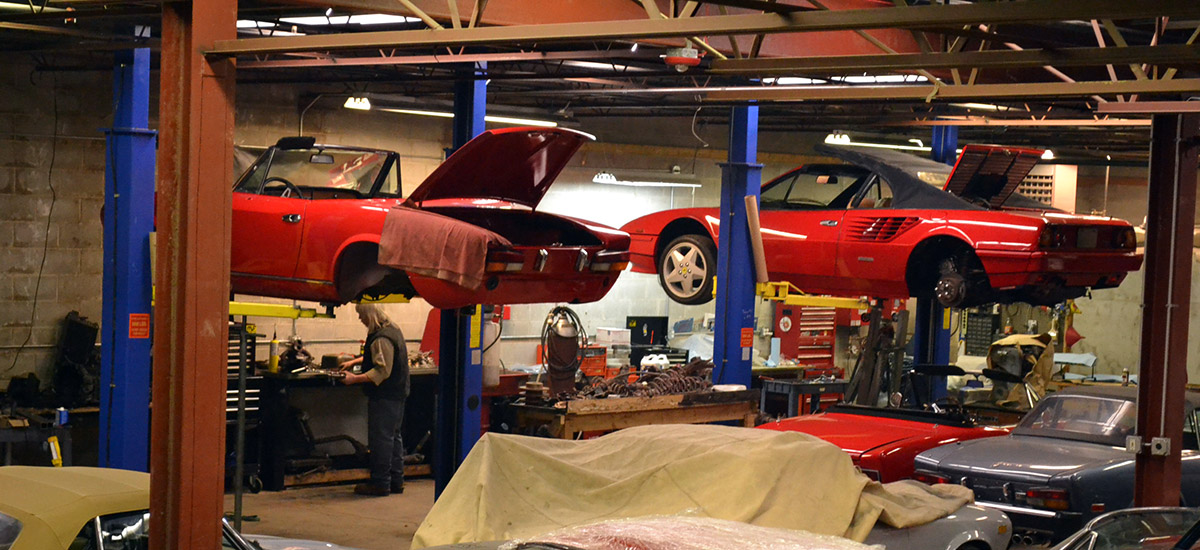
After years of only servicing our own restoration customers, Roadster Salon has expanded our service capabilities to help customers who are currently being turned away from their local Fiat-Alfa-Maserati franchised dealer service departments. “Unfortunately, in nearly all cases these dealers are only trained on the new models by the factory. They have zero interest or expertise in working on the vintage models. That leaves owners of older Fiats and Alfa Romeos out in the cold.”
As an FYI, we can also service newer Fiat models including the Abarth and 124. Roadster Salon now offers labor discounts to Italian car club members. Call about our appointment schedule, as we anticipate longer lead times until staff is ramped up to accommodate demand.
15 minutes of Spring and its almost Summer—Dionisio Project heads into June

Managing multiple projects at the same time requires a great deal of coordination and a little luck. This year, the testing of late stage projects has taken on quite a bit of headwind. From relentless rain to the seemingly unending grip of Winter, Mother Nature has not done Roadster Salon any favors this year. Virtually every project has fallen behind. With the weather not breaking until early May, frustration with our lack of ability to road test has put the entire staff on edge.
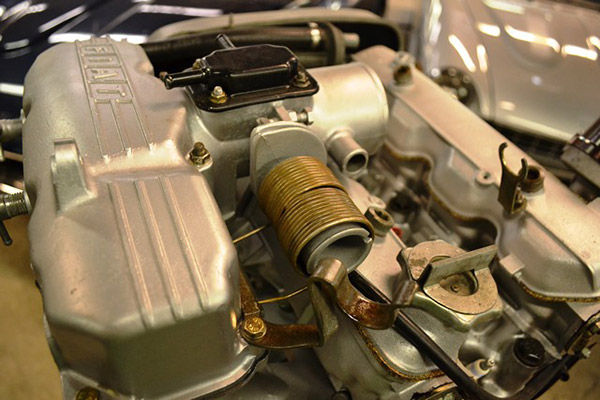
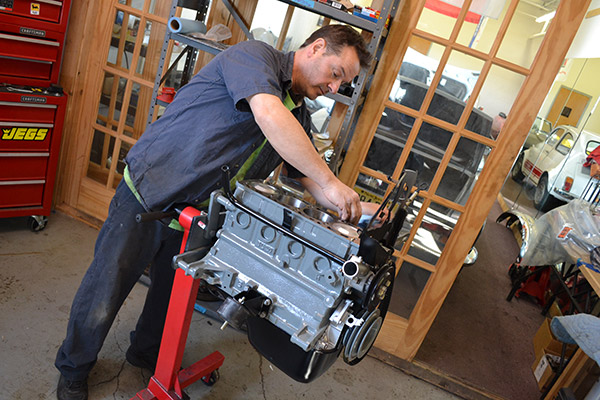
Timing concerns with the ability to take delivery overseas over the Summer has provided some flexibility on the Dioniso build. While originally planned for an unveiling during July, the delivery date has been pushed back to September to coincide with the Dioniso family’s travel plans. Engine and Mechanical phases continue with the body work completed and interior progressing. With the revised time line, interior assembly will be pushed back to August. This will give us time to attend to other projects while keeping the Dionisio build on schedule.
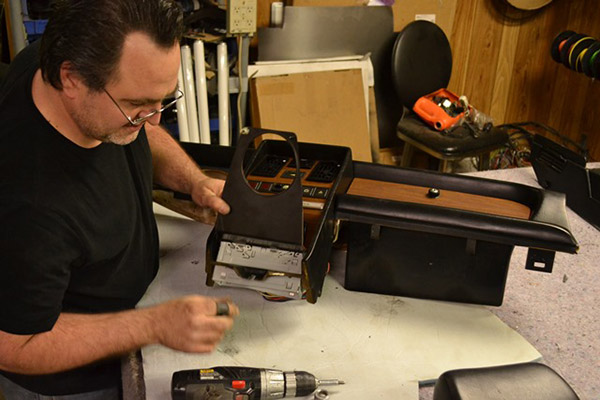
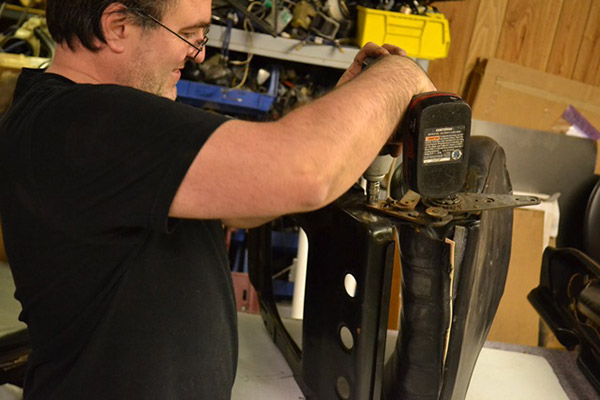
Rob Baird commented further: “I think it is critical our customers understand time lines on custom builds are only broad estimates. There are just too many variables to hold to exact delivery dates. Take in context, Roadster Salon is one of the only high line restoration and engineering shops on the planet who have fixed pricing rather than billing for labor hours expended. Our staff is on salary. They are purposefully not incentivized for working quickly. We don’t want quality to suffer.”
Some projects amass labor logs that literally exceed one thousand man hours. If we billed a customer for literally every minute we spend on a build—the cost would be astronomical.
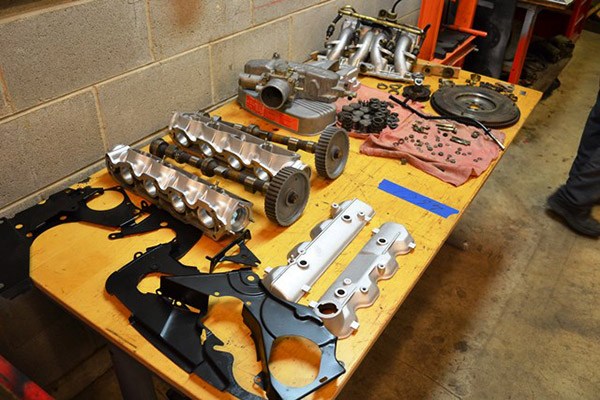

End of April, and snow still on the ground. Take me to Miami.
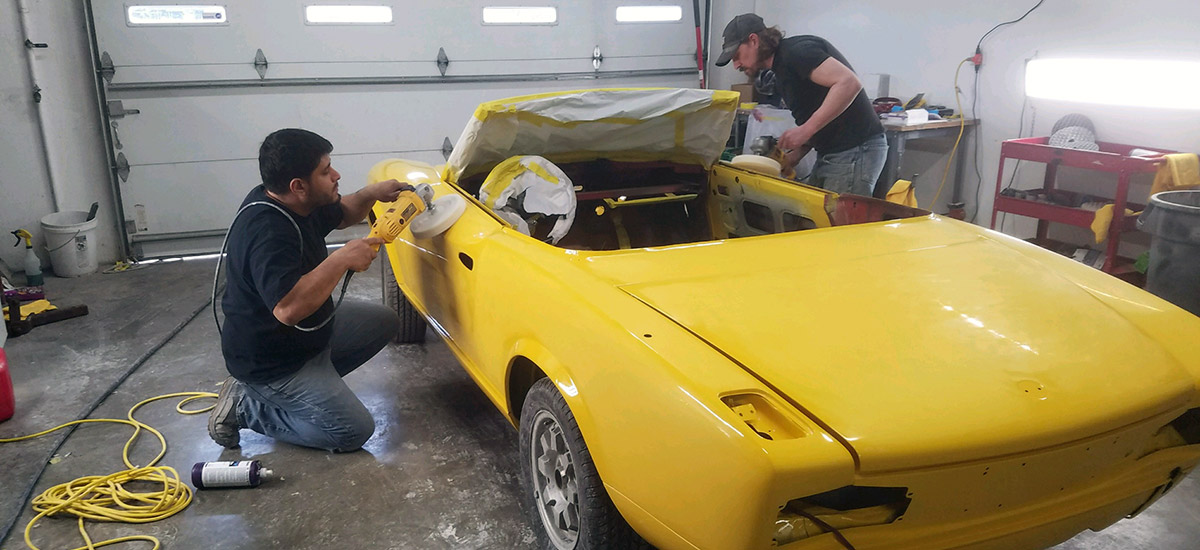
While Winter’s grip has lasted much longer than anyone cares for, Roadster trudges on. Very frustrating to be looking into May still wearing your parka from Eddie Baur. Pleased to report a stunning result from the body shop, with the Dioniso spider receiving some of the best paint work we have ever done. As shown in the photos, the meticulous attention to detail given to our mechanical and interior work is also reflected in our exterior treatment.
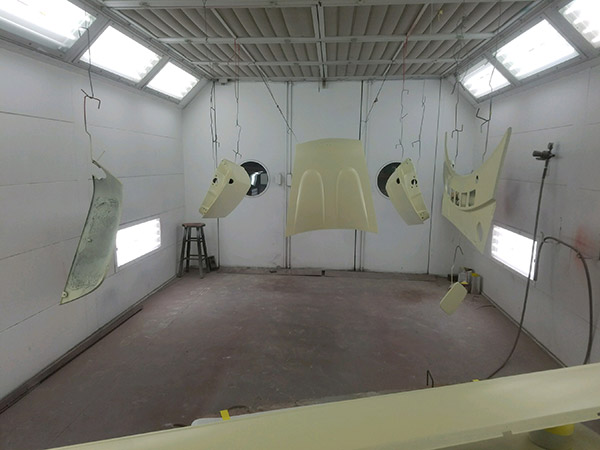
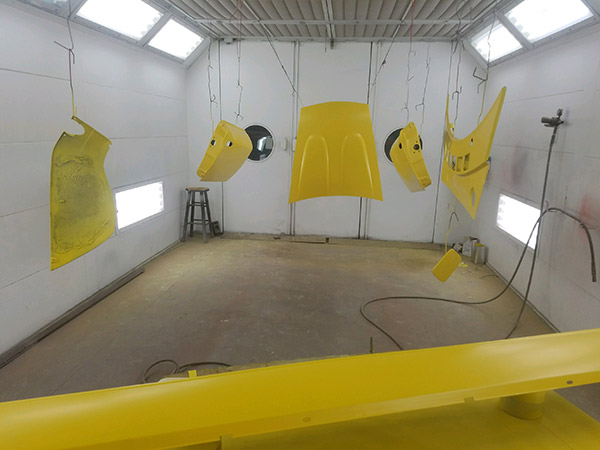
Operations Manager Rob Baird explains: “You can paint a car for $2500 or $25,000. While the quality and quantity of materials used is certainly important, the key to a stunning paint job is all in the details. Preparation, execution and finish work are all critical. It all comes down to how much time you want to spend. How many hours were allocated to carefully sanding and blocking each panel? Was the car painted horizontally or vertically? Like all the best shops, Roadster uses at least two coats of primer, and multiple coats of paint and clear in every project. But to get a show quality mirror finish, days must be spent wet sanding and cutting the paint after it leaves the booth. No way around it.”


During the paint phase, other work is also being done concurrently at our facility. Engine and transmission building by famed artisan Roberto D’Avola takes center stage while the chassis is at our body shop. “I started building motors when I was a child in Italy with my brother. It is still my passion. I spend weeks building a single engine and I sign every one personally,” D’Avola said enthusiastically. Rob Baird added “Roberto is a trues craftsman. Over the years he has developed so many tricks Undercarriage component fabrication by our engineering department and other mechanical work are all in progress simultaneously. Now that the Dionisio Family has selected the leather, construction of the custom interior can also move forward.
Insert photos
A month later and no sign of Spring, Dioniso March Update
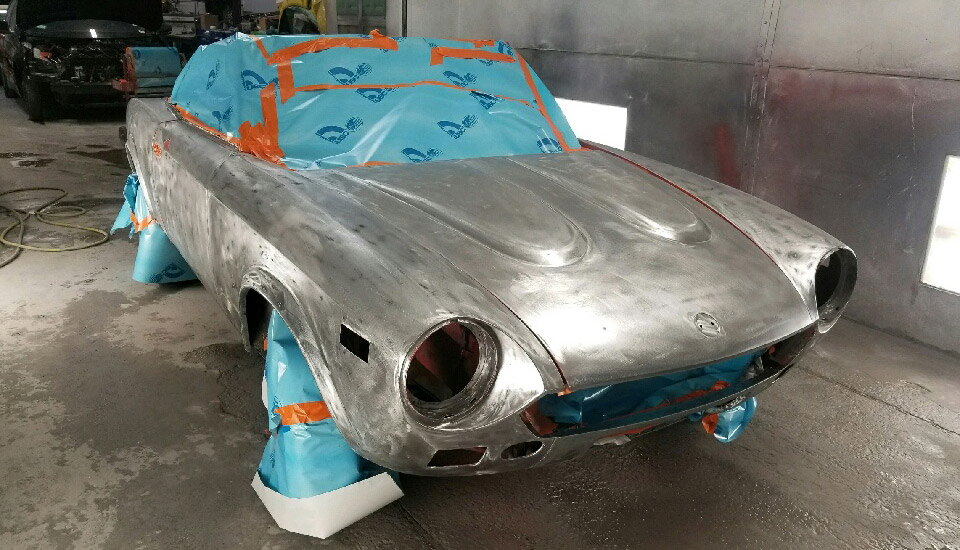
In the last six weeks the groundhog saw his shadow, and the nasty Winter continues. Inside work is all that is possible at this time of the year, and Roadster uses this opportunity to focus on the mechanical, body and interior stages of our projects. Once the Dionisio car was fully stripped, the chassis was media blasted. Higher end builds include the paint stripping of the undercarriage as well as the exterior and tub. Exposing areas of concern is always our first priority. Since we don’t have X-ray vison, we simply can’t trust what we see on the surface. We simply won’t know what may be lurking underneath the paint unless it is removed.
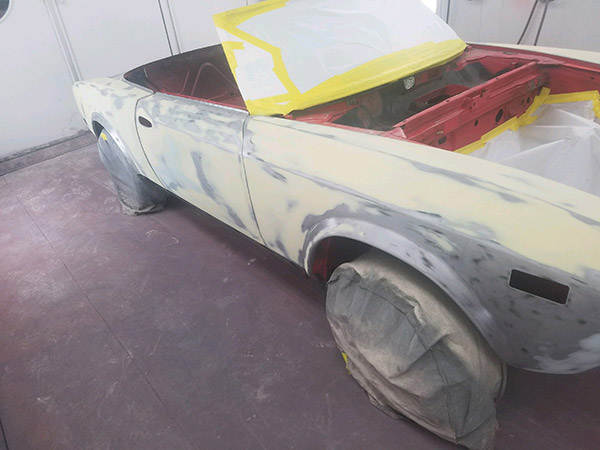
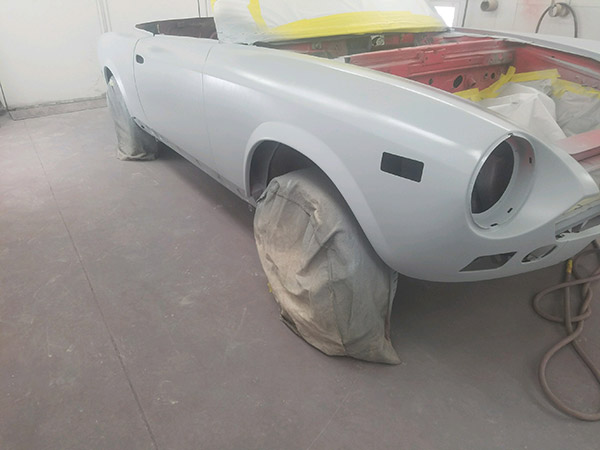

Luckily, this chassis was from a Southern climate. Previously undercoated cars can be a mixed blessing. While the material does protect against rust to a degree, it also can hide oxidation—especially if it was not applied properly or when the car was brand new. We have seen many examples that looked solid at first glance–but were a basket case once the undercoating was removed. The Dioniso undercarriage was very clean and without issue.
As shown in the photos, our Dionisio starting point presented few challenges for our body shop. While it is true to some degree that anything can be fixed with time and money, it certainly makes for a more efficient project when a project is based on a solid platform.
While all Roadster Salon chassis are carefully vetted before being eligible for our restoration program, about 25% of our customers provide their own. Typically, these are spiders that belonged to other family members and have sentimental value. “We see spiders that have been stored for years and are too far gone to save economically. But some customers insist that we move forward, regardless of rust concerns. If directed to do so, we can restore a car that has been sitting at the bottom of the ocean.”
It is February, and it’s freezing in Chicago. Dionisio Update
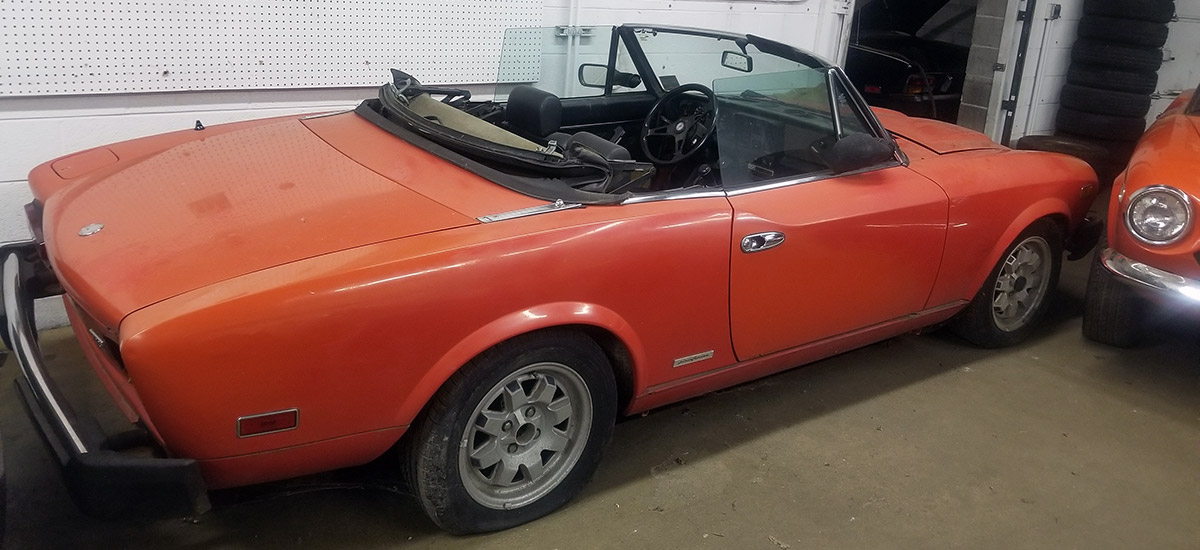
After careful consideration, a particular vintage shade of Ferrari Fly yellow was finalized for the exterior color. Leather samples are still being discussed. So far, the creative dynamic established between Roadster, Mr. Dionisio in Europe and his son in California has been a bit of a model of cooperation. Like all projects, the devil is in the details. Some of the fine points of the build are still being debated—but we are making progress. Fortunately, the initial build sheet provides a solid platform to work from. It isn’t necessary to make final decisions about trim or interior finishes during the first stages of the build.
All mid-level and higher restorations require the complete disassembly of the chassis. This includes having all mechanical components and trim removed and the car stripped down to the bone. This is an arduous task. According to Senior Technician Ken Zeuchel, the process of removing all components and meticulously cataloging each item can take weeks or even longer. “The key is whether the particular build is being done to an original standard—or if the project’s goal is to update the spider using our exclusive contemporary technology. Obviously if the car is one of our fully re-manufactured models, there is not a whole lot left of the original car that is retained other than the tub.”
Production Tech Errol Reid calls this the “Piranha phase” because nothing is left but the bones when he is done. “It may seem to be a little random, but we have a system for how these cars are taken apart. It can cause big problems later if we are not careful removing everything. I learned this the hard way.” Once the car is completely stripped of its components, work on the body begins in earnest.
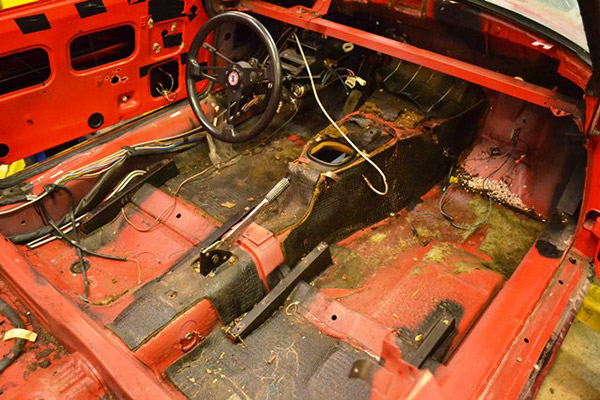
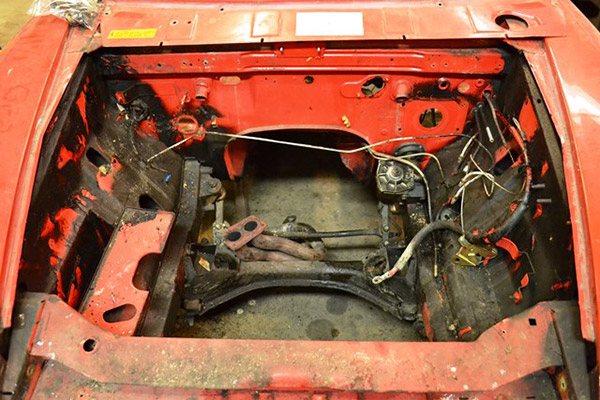

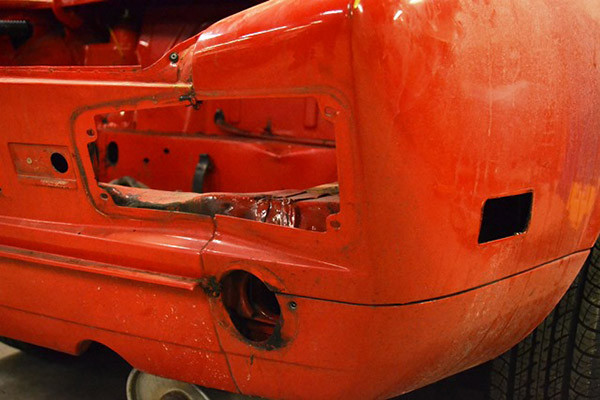
The Dionisio Project—A Roadster Salon build in real time
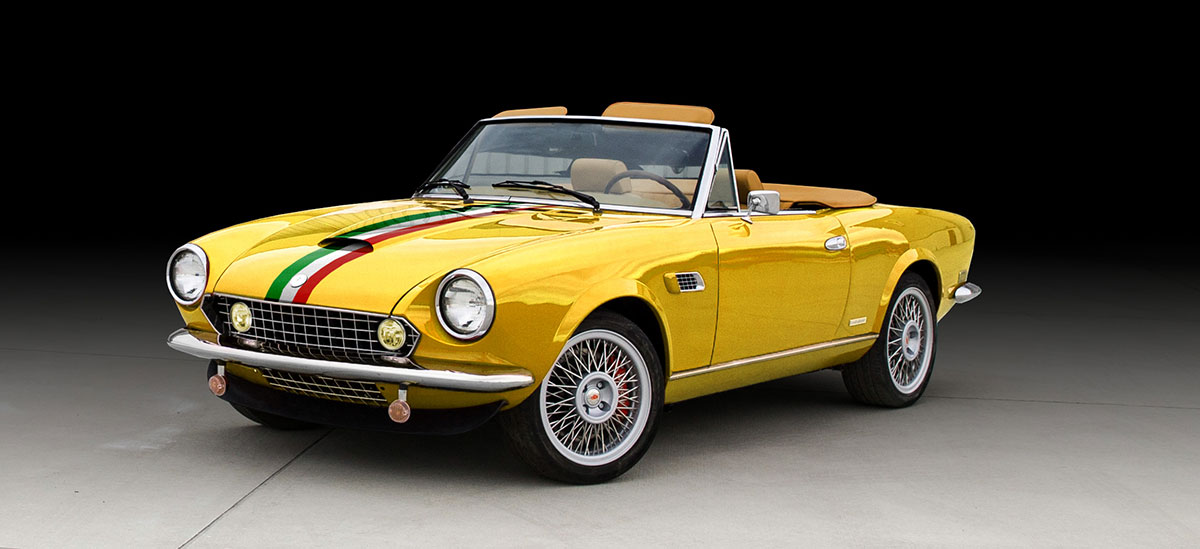
We have been asked repeatedly about chronologically following a full restoration in real time on our blog. Several weeks ago, we were contacted by a customer in Switzerland and his son in California about helping them realize their vision of a custom spider, based on our Spider Tributo model. This design would incorporate cosmetic elements of our Spider America (CE), such as the revised proprietary body panels, but would retain the stock Fiat drive line. A computer rendering of their vision was provided, and shown below.
We spoke for several weeks about chassis selection, custom features, build process, scheduling, and time line. In early December, we settled on a 1983 Pininfarina from our inventory with 50K original miles as the basis for their project. We selected this chassis for its rarity, rust free tub, original paint, documented low miles, and overall value. Custom builds like the Dionisio Project typically undergo multiple revisions during the restoration process. However, it’s important that a build sheet finalizing the general restoration parameters, options and pricing are agreed upon before work actually begins. It’s a flexible blueprint that can always be changed, but keeps everyone’s eyes on the same target.
The chassis selection, initial build sheet and deposit was finalized several days ago, and the Spider was moved from “cold storage” to our active build area for disassembly. The chassis will be taken down to the bare tub, including removal of all mechanical and electrical components. It will then be media blasted down to bare metal and sealed before body work is started by our technicians. We will be sending our customer 3 spray-outs of color options they selected on metal thin sheets, as well as leather options for the interior.
During the course of this build, which we estimate to take from 6-9 months—Roadster will be updating our readers periodically as the Dionisio Project passes through its respective phases. We’ll be checking in with photos and commentary on our Blog so our readers can follow along with the twists and turns as they occur in real time. We are very excited to share this process in a more up close and personal way than we have in the past.
Upgrades Improve Safety Too
Recently an article published in AARP Magazine raised the notion that classic cars designed in the 1960’s and 1970’s are unsafe by today’s standards. There were six areas pointed out by veteran collector Gordon McCall as suspect in classics built prior to the wave of safety requirements mandated in the early 90’s. Inadequate seat belts, poor braking systems, out dated tire design, worm/roller steering systems, sub-standard head lights and the lack of back-up cameras were all sited by McCall as potential safety hazards. While certainly concerning, it should be noted that Fiat/Pininfarina Spiders were ahead of their time compared to other classic sports cars from the same era.
Interestingly, proprietary safety and performance upgrades have been the focus of Roadster Salon’s engineering and development team for nearly a decade. While my Dad was fiercely loyal to keeping his restorations as original as possible, he grudgingly admitted that the Spider had not aged well in certain areas. I remember having spirited debates with him in years past about the necessity to upgrade the Spider to be more in tune with today’s roads and driving conditions. The Spider was already lagging in performance and technology by the mid 1980’s. Unlike fine wine, it has not gotten better with age. Frankly, it never made sense to me that as a company Roadster’s goal should only be to make the car as good as it was when new in 1984.
The Spider deserved more.
Following my Dad’s passing in 2012, our efforts to re-engineer the Spider intensified. We took out a clean sheet of paper and outlined the car’s biggest weaknesses. Aside from fit and finish–braking, steering, structural integrity, electrical reliability, handling, and comfort were all areas where marked improvement was necessary. Today, each of the items noted by Gordon McCall in the AARP article can be addressed in every Spider restoration. It’s simply a matter of priorities and budget.
Our Lusso S2 and Tributo models are brimming with new technology. Both come standard with Generation II rack and pinion steering, revised electrical systems, structural chassis bracing, advanced suspension upgrades, dramatically improved braking with contemporary wheels and tires, better seat belts, HID lighting, and yes—even optional back up cameras. The Tributo also features a revised instrument panel that is not only beautiful, but easier to read, more accurate and details more information. Any of these items can be added to basic Spider restorations as a package or on an individual basis.
While there are no plans to incorporate air bags or anti-lock brakes into Roadster Salon Spiders, improving safety by building a car with more contemporary reflexes and road manners is a huge step in the right direction. On today’s roads traffic is faster, and things happen much more quickly. Upgraded Roadster Salon Spiders can stop, turn and accelerate in a manner that’s closer to the average car around them. This makes for a safer and more pleasant driving experience—which is as much as you can expect from a classic car.
ROADSTER SALON BUILT SPIDERS TAKE 1st and 2nd PLACE AT 2017 NATIONAL FIAT SHOW
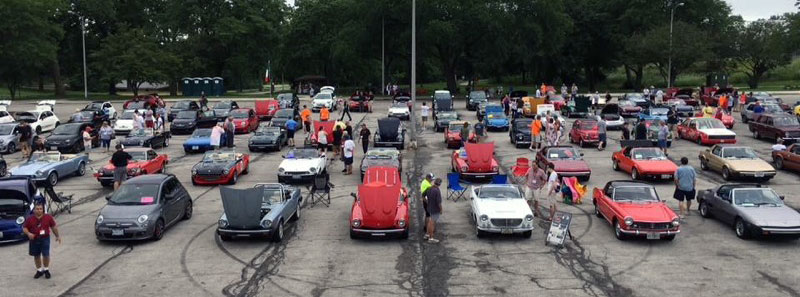
For the second consecutive year, and fourth in the last five, Roadster Salon spiders dominated the Annual National Fiat “Freak-out” car show. The event featured Italian car entries from Fiat and Alfa Romeo. Two Roadster Salon creations were entered in the competition, finishing 1st and 2nd respectively. Both cars garnered tremendous attention from judges, entrants and fans.
The First Place finisher was a 2016 Roadster Salon Spider Lusso S2—our original second generation prototype. Based on a 1983 Pininfarina Spider, the stunning Azzurra Blue exterior was beautifully complimented by a contrasting light tan interior and custom makore wood dash. Commissioned by Vince Bonanno in New Jersey, this stunning example was previously featured in several national photo spreads. It is currently being upgraded at our facility in Barrington.

The Salon’s second entry was a 2016 Lusso S2 Speciale, owned by perennial show winner Nate Westgor. You may recall his Salon built 1985.5 Pininfarina has won numerous awards at National events, including several top honors at past Fiat and Italian car shows. The Speciale is one of three spiders Roadster Salon has built for Nate in the past five years.
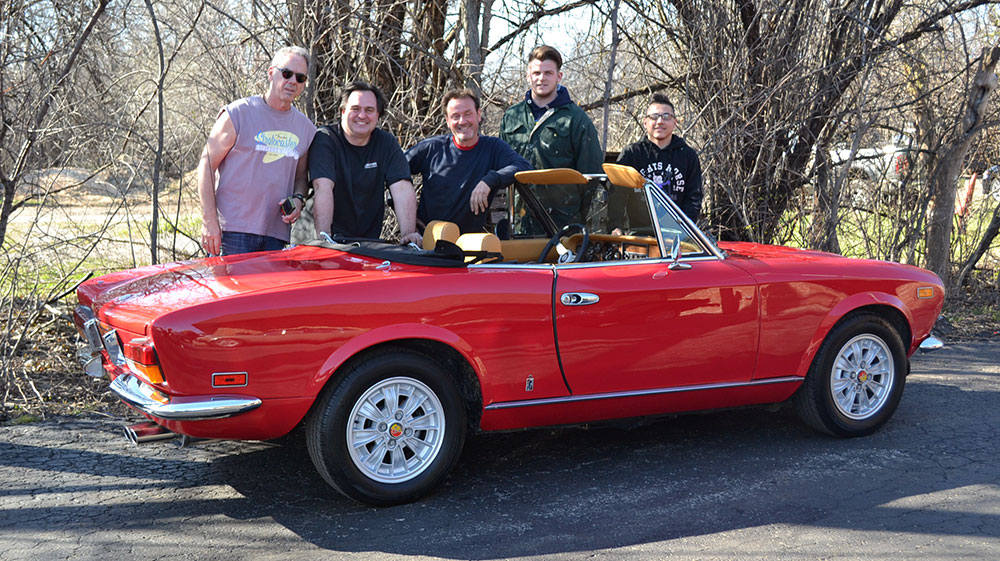
Based on a 1980 Fiat Spider, this Lusso is Nate’s daily driver. It featured several unique custom touches fashioned at his request—including rare vintage wheels and enhanced drive train. The flawless paint in traditional Ferrari red with saddle interior is an Italian car staple—and a crowd favorite. The exclusive grille work, light weight bumpers and custom suspension completed the look. Harkening classic Spiders from the 1960’s, Nate’s updated mechanicals make it perfectly agreeable with daily use. This lovely car is no one trick pony. Roadster Salon’s engineering upgrades make it equally at home on long trips as it is on back county roads.
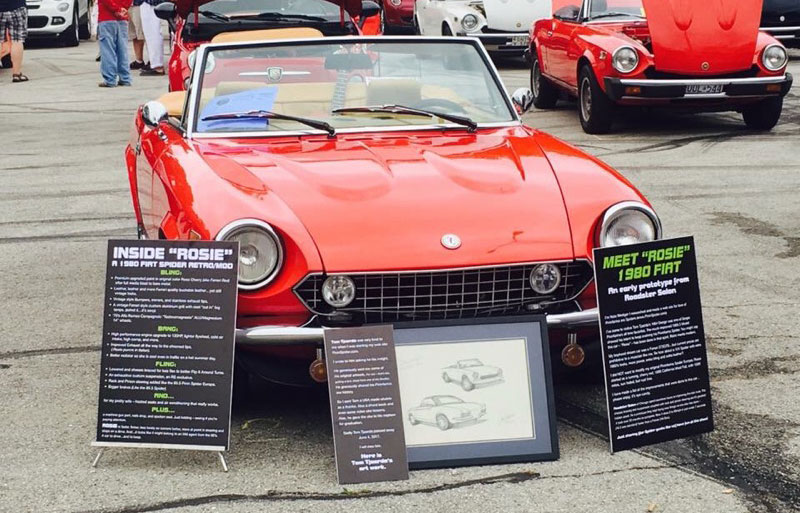
Missing from the event was Roadster Salon’s planned National introduction of their Tributo Spider—a new model based on their current Lusso S2. According to Roadster Salon’s Marketing Director Ray Marchica “We are really close. The prototype has been very well received and we are in the process of finalizing specifications and pricing. We think it is the best driving and most beautifully finished Fiat based Spiders we have ever built.”
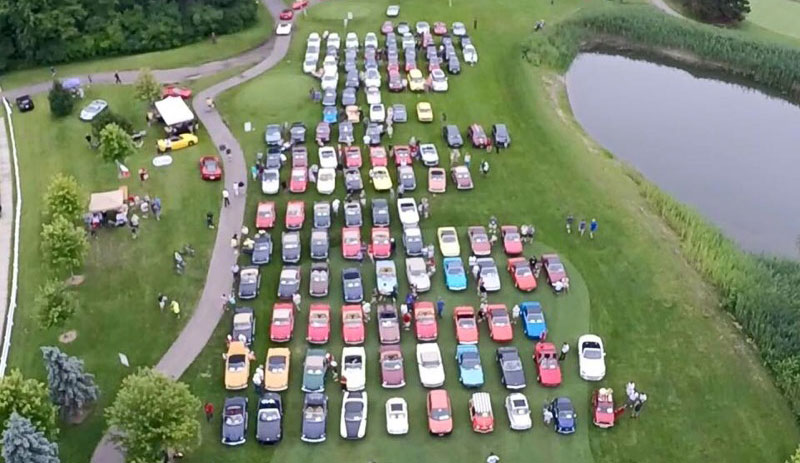
Sad, familiar tale with happy ending
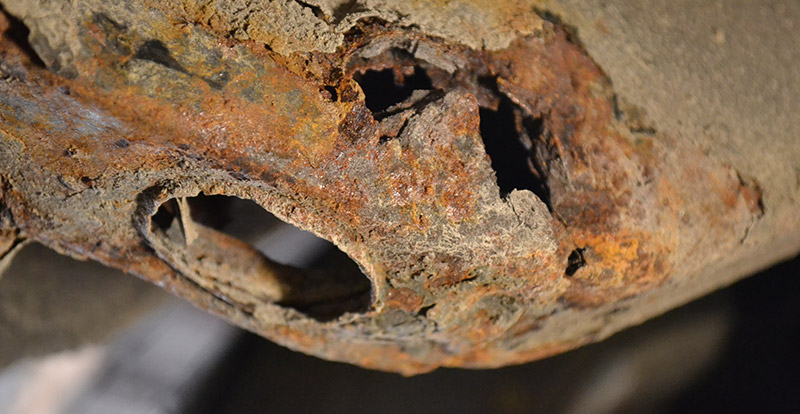
A few months ago we received a call from an enthusiastic owner of a 1976 Fiat Spider that had been in his family for many years. Stored much of that time, it was sorely in need of restoration. Per usual, we had the car shipped to our facility to be evaluated. About 20% of Roadster Salon’s annual output is restoring customer supplied spiders, rather than examples selected from our inventory.
Some customer owned spiders sent to us are certainly worthy of restoration. However, more frequently, the spiders we inspect have fallen victim to an Italian car’s worst enemy—hidden rust. Structural corrosion, specifically in the shock towers makes a spider difficult if not impossible to safely repair. Frankly it makes little sense to restore a spider, (regardless of sentiment) if the car is not structurally sound. Would you spend thousands of dollars remodeling a home built on a crumbling foundation? Not likely.
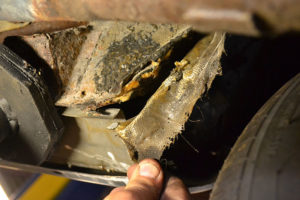 You can see where this story is heading. Even though Charlie’s car was from a Southern climate, it hadn’t always been stored on pavement. At first glance, his spider looked promising. There appeared to be only minor surface rust on the rocker panels and wheel arches. The interior had been re-freshened recently. But as we looked closer, things started heading downhill rather quickly. We lifted the carpets and were shocked to see the pavement through several soft-ball sized holes in the floor boards. Seat mounting points were brittle and unsafe. While floor repairs can be relatively benign, what we discovered underneath wasn’t.
You can see where this story is heading. Even though Charlie’s car was from a Southern climate, it hadn’t always been stored on pavement. At first glance, his spider looked promising. There appeared to be only minor surface rust on the rocker panels and wheel arches. The interior had been re-freshened recently. But as we looked closer, things started heading downhill rather quickly. We lifted the carpets and were shocked to see the pavement through several soft-ball sized holes in the floor boards. Seat mounting points were brittle and unsafe. While floor repairs can be relatively benign, what we discovered underneath wasn’t.
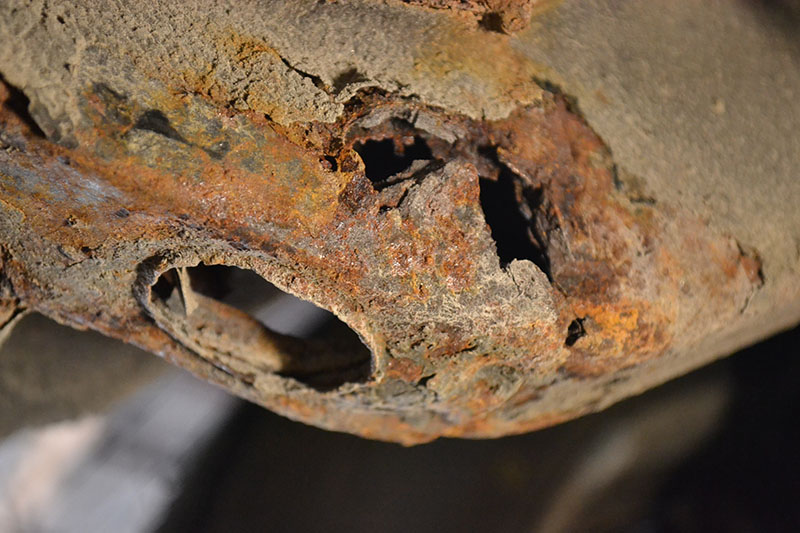 Up on the lift, even more serious structural rust in the rails adjacent to the seats was noted. This meant there was nothing solid to weld potential new floor sheet metal to. It got worse. We removed the tires and saw significant rust in the shock towers that was not visible from the engine compartment. We sadly pronounced the car D.O.A, and remanded it to parts car heaven immediately.
Up on the lift, even more serious structural rust in the rails adjacent to the seats was noted. This meant there was nothing solid to weld potential new floor sheet metal to. It got worse. We removed the tires and saw significant rust in the shock towers that was not visible from the engine compartment. We sadly pronounced the car D.O.A, and remanded it to parts car heaven immediately.
However, the dark cloud hovering above Charlie’s beloved 1976 had a silver lining. Before sending us his spider, we discussed a restoration budget in the $20-25K range. The scope of work was to include paint, mechanical repairs and a modest interior upgrade. But once it became clear that such expenditure would be pointless, we explored more prudent options. A few times a year, as part of our exclusive upgrade program, Roadster Salon gets back an entry level restoration in trade-up on a Lusso or higher-end model.
Sitting under a cover in our climate controlled storage building sat a lovely black, rust free 1984 Pininfarina Azzurra Spider with only 50K miles. This was an original spider, lightly restored by our team several years ago. All considered it was the perfect solution to Charlie’s restoration dilemma. We arranged a trade credit for his 1976 parts car—and following a month long certification process, Charlie’s 84 Pininfarina was ready for delivery. And the price was not much more than his original restoration budget! We were even able to provide some financial assistance through JJ Best Capital. Here’s Charlie with his beautiful (and rapidly appreciating) 84 Pininfarina Spider.
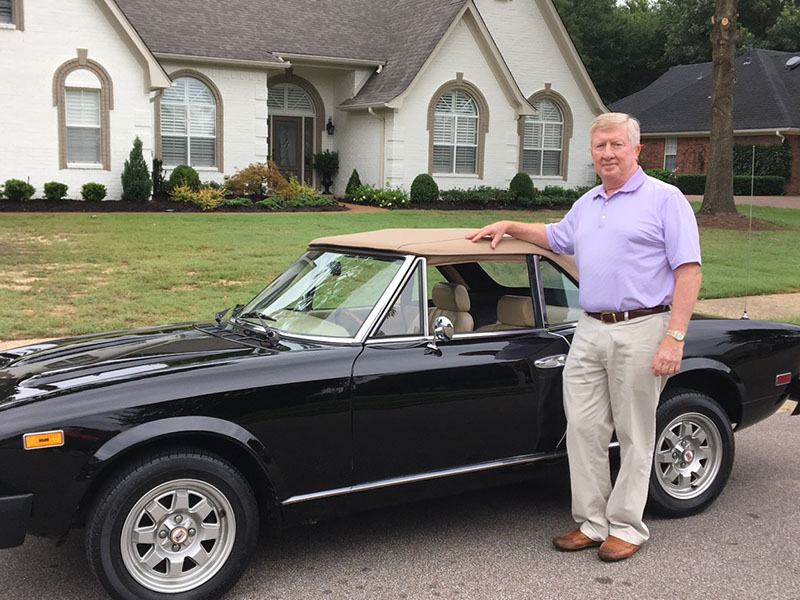
Please feel free to inquire about other trade-up spiders we may have in our inventory. They may be ideal alternatives to full restoration projects at more affordable price points. Contact us today!